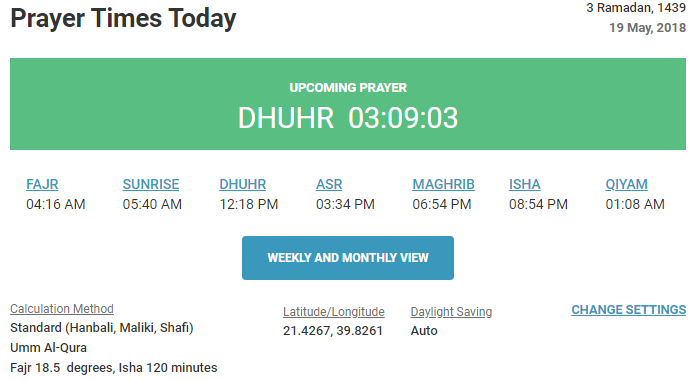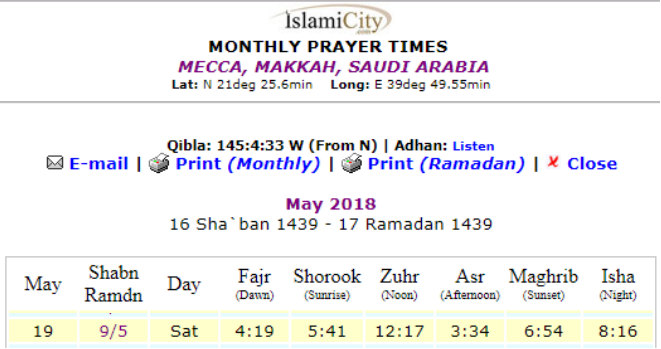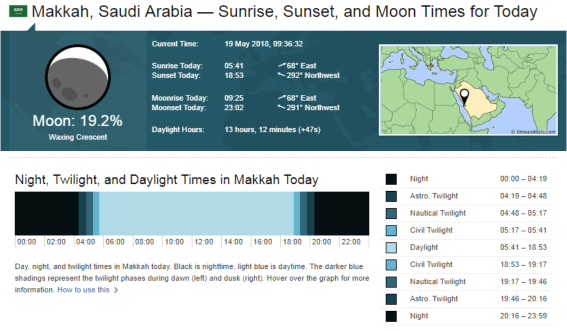Question and Answer
It is recommended that you run through the following list of Questions & Answers. It is likely that your questions are already handled. If not, simply send us an inquiry... ツ
This website is about prayer times for high latitude areas (45deg North and beyond). Among many proposed solutions throughout the history on how to determine prayer times for high latitude areas, this website promotes the implementation of combined prayer times, that is local time during normal period and standard Makkah time during extreme period. Needless to say that the time tables presented here are intended to cover the whole year and not only specific during Ramadan.
Let us discuss this issue by first considering case study for 19th May 2018. First of all, let us see what is the prayer time schedule for Makkah:
Taken from https://www.islamicfinder.org

Taken from http://www.islamicity.com

Afterward, let us see what is the astronomical calculation show us. Referring to the source www.timeanddate.com for 19th May 2018:

The above figure presents:
- Twilight start : 04:19 (corresponds to Fajr).
- Sunrise : 05:41 (corresponds to end of Fajr).
- Sunset : 18:53 (corresponds to Maghrib).
- Twilight ends: 20:16 (corresponds to Isha).
I think we can agree that the first sources (Islamic Finder and Islami City) and the second source (timeanddate) are well aligned, which means the applied Makkah time at Makkah found at both sources (Islamic Finder and Islami City) is correct with respect to astronomical calculation.
Now, let us see what is mentioned in the prayer time table presented in this website for Oslo as uploaded here. It says: 19; Sat; 05:15; 06:35; 13:23; 16:31; 19:51; 21:11 for date; day; Fajr; sunrise; Duhr; Asr; Maghrib; Isha respectively. According to this schedule, we start fasting (also Fajr prayer) at around 5:30. It means there is “approximately one hour” difference with the real Makkah time as shown before. Why?
The answer can be found here. Please scroll down of the box at the right hand side and find “Time Zone”. It says Norway follows CET (UTC+1). This is the standard adopted time and valid during winter. While in summer, Norway applies DST (Daylight Saving Time), such that follows CEST (UTC+2). Noted: CET: Central European Time, CEST: Central European Summer Time, and UTC: Coordinated Universal Time. In short: the “true time” for Norway is during winter. While the “false time” for Norway is during summer, when there is one hour correction from the true time. Example is. If today (19.05.2018) the clock shows 05:15, then the true time is actually 04:15. With this regard, then the prayer time table presented in this website for Oslo is in fact adopting the Makkah time.
But, why the difference is approximate one hour instead of exactly one hour, if the reason for the difference is due to the DST (Daylight Saving Time)? Well… there are several answers:
- The very obvious reason is due to accuracy of the calculation when implementing round up procedure in the computer code. But this should be in the order of 1 minute.
- The not so obvious reason, but it is significant and important, but also probably the most difficult to understand is because of the difference position of both cities (Makkah and Oslo) relative to the reference longitude line of the time zone. You may see this map to evaluate what I meant. Makkah is located at 39°49′0″E=39.8167°E and its reference longitude line for UTC+3 is 37.5°E — 52.5°E. Makkah position relative to 37.5°E is 2.3167°. While, Oslo is located at 10°44′E = 10.7333°E and its reference longitude line for UTC+1 is 7.5°E — 22.5°E. Oslo position relative to 7.5°E is 3.2333°. Now, the difference between these two cities is 0.9166°. In time unit, it is equal to 219.992 seconds or 3.67 ≅ 4 minutes. Because Oslo is located more eastern to the reference longitudinal line as compared to Makkah, then logically the time in Oslo will goes first and then afterward Makkah with time difference of 4 minutes. Therefore, we have approximately 1 hour and 4 minutes difference between the prayer time in Makkah and the (adopted Makkah) prayer time in Oslo.
Why we need to perform such complicated approach? Why we don’t just apply the time in Makkah directly? It is much simpler, isn’t it? Well… the answer should be logic for anyone. The reason is we have to be consistent! Consistent in which sense? Well… When we in Oslo developing the standard Makkah time for Oslo, we did not look it at solely for Oslo, but for bigger area, e.g. Norway or even Scandinavia. Now, let us imagine the earth as a globe. Then point your finger to an arbitrary location (let say around the equator line, to make it simpler). Afterward, you turn the globe such that it rotates just exactly like the earth rotate in its axis, i.e. it goes from West to East. Opposite to that, your finger actually points to the Eastern part first and then the Western part. And also the time to make adzan (call for prayer) should be the Eastern part first and then the Western part. Now, if whole Norway has the same time zone (in fact yes), then the adzan should be performed consecutively, from the Eastern part of Norway until to the Western part of Norway. It should be consecutively, not at once! If we apply exactly the time in Makkah directly, then it is absolutely in any where of Norway, they will make adzan all at once! If this is to happen, we fail to be consistent with the nature of the earth rotation as Allah SWT has created.
However, fortunately, there is simpler approach. By setting the longitude as the same as the local area (e.g. Oslo) and setting the latitude as the same as Makkah latitude, and then perform the astronomical calculation, then we will end up with the same result as if we make correction above.
Please make a note, that the time of Makkah is adopted only during the extreme (abnormal) period. The definition of extreme (abnormal) period are as follows (all are the same).
- when we do not have the true night,
- when we always have red-cloud, whether at all sky, or at eastern horizon, or at western horizon.
- when we cannot differentiate between the end of Maghrib, the beginning and end of Isha, and the start of Fajr. All are blend together.
- when the sun never goes down more than 18 degree below horizon.
If we have perfect night, then we apply the local time correctly according to local astronomical phenomena. In addition, there is 30 days transition between the normal and extreme period.
Refering to hadith xxx, Asr time begins either when the shadow is the same as the length of the object (denotes as one time shadow) or twice the length of the object (denotes two times shadow). However, note that for most of the times there always be shadow at noon. Therefore, the one time shadow and two times shadow should be calculated in addition to the length of the shadow at noon.
The formula is given in xxx. More elaboration on this topic is given in xxx and xxx.
Maghrib time means at sunset time. Sunset is defined as the instant in the evening under ideal meteorological conditions, with standard refraction of the Sun's rays, when the upper edge of the sun's disk is coincident with an ideal horizon.
In the otherhand, sunrise marks the end of Fajr prayer. Sunrise is defined as the instant in the morning under ideal meteorological conditions, with standard refraction of the Sun's rays, when the upper edge of the sun's disk is coincident with an ideal horizon.
The formula is given in xxx. More elaboration on this topic is given in xxx and xxx.

Noon time here refers to solar noon. Solar noon is the moment when the sun transits the celestial meridian – roughly the time when it is highest above the horizon on that day. The celestial meridian is a great circle on the celestial sphere passing through the celestial poles and an observer's zenith. At northern hemisphere, the sun will be at south at noon.
Noon time is different with Duhr time. Refer to hadits xxx, Duhr prayer should be offered a few moment after the noon time as to let the sun moves a bit from its highest position in the day.
The formula is given in xxx. More elaboration on this topic is given in xxx and xxx.
Isha begins when the red twilight or the whiteness at the western horizon disappear and the sky becomes dark. This corresponds to the sun's position at approximately 18 degree below western horizon.
Fajr begins when Fajr sadiq appears at the eastern horizon. This corresponds to the sun's position at approximately 18 degree below eastern horizon.
The formula is given in xxx. More elaboration on this topic is given in xxx and xxx.
- one or more astronomical phenomena to determine the prayer times does not exist, and/or
- the fasting time is more than 18 or 20 hours, and/or
- the length of the day (sunrise to sunset) is less than 4 or 6 hours.
First of all, one must calculate the astronomical phenomena (i.e. twilight rise, sunrise, noon, sunset, twilight set and midnight) times for the whole year. Visually the astronomical phenomena times may be plot in a figure.
In order to determine if there is any summer extreme period and its corresponding limits, the following checks focusing on summer (or even could start from late spring to early autumn) can be done:
- Check if the sun is always above the horizon. The limit is indicated by the sunrise and sunset curves meet at midnight curve.
- Check if the sun never goes 18 degree below the horizon. The limit is indicated by the twilight rise and twilight set curves meet at midnight curve.
- Check the fasting time, i.e. the time from Fajr until sunset. If there is no Fajr (or Fajr is coincides with midnight), then it is the time from midnight until sunset. The limit is when the fasting time is equal or more than 18 hours or 20 hours.
The limit which gives the longest period of summer extreme period is selected.
In order to determine if there is any winter extreme period and its corresponding limits, the following checks focusing on winter (or even could start from late autumn to early spring) can be done:
- Check if the sun is always below the horizon. The limit is indicated by the sunrise and sunset curves meet at noon curve.
- Check the length of the day, i.e. the time from sunrise until sunset. The limit is when the length of the day is equal or less than 4 hours or 6 hours.
The limit which gives the longest period of winter extreme period is selected.